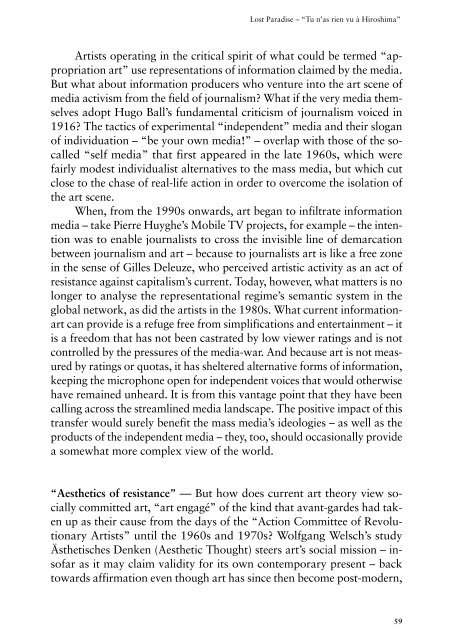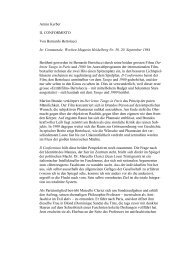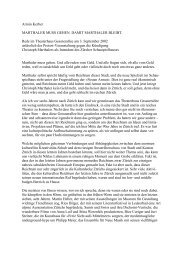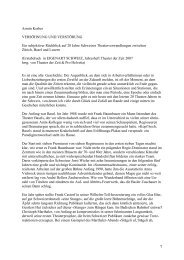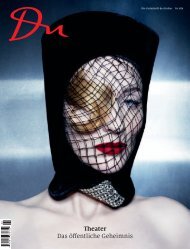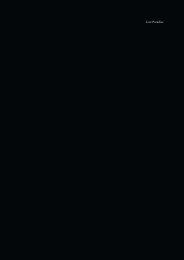Create successful ePaper yourself
Turn your PDF publications into a flip-book with our unique Google optimized e-Paper software.
<strong>Lost</strong> <strong>Paradise</strong> – “Tu n’as rien vu à Hiroshima”<br />
Artists operating in the critical spirit of what could be termed “appropriation<br />
art” use representations of information claimed by the media.<br />
But what about information producers who venture into the art scene of<br />
media activism from the field of journalism? What if the very media themselves<br />
adopt Hugo Ball’s fundamental criticism of journalism voiced in<br />
1916? The tactics of experimental “independent” media and their slogan<br />
of individuation – “be your own media!” – overlap with those of the socalled<br />
“self media” that first appeared in the late 1960s, which were<br />
fairly modest individualist alternatives to the mass media, but which cut<br />
close to the chase of real-life action in order to overcome the isolation of<br />
the art scene.<br />
When, from the 1990s onwards, art began to infiltrate information<br />
media – take Pierre Huyghe’s Mobile TV projects, for example – the intention<br />
was to enable journalists to cross the invisible line of demarcation<br />
between journalism and art – because to journalists art is like a free zone<br />
in the sense of Gilles Deleuze, who perceived artistic activity as an act of<br />
resistance against capitalism’s current. Today, however, what matters is no<br />
longer to analyse the representational regime’s semantic system in the<br />
global network, as did the artists in the 1980s. What current informationart<br />
can provide is a refuge free from simplifications and entertainment – it<br />
is a freedom that has not been castrated by low viewer ratings and is not<br />
controlled by the pressures of the media-war. And because art is not measured<br />
by ratings or quotas, it has sheltered alternative forms of information,<br />
keeping the microphone open for independent voices that would otherwise<br />
have remained unheard. It is from this vantage point that they have been<br />
calling across the streamlined media landscape. The positive impact of this<br />
transfer would surely benefit the mass media’s ideologies – as well as the<br />
products of the independent media – they, too, should occasionally provide<br />
a somewhat more complex view of the world.<br />
“Aesthetics of resistance” — But how does current art theory view socially<br />
committed art, “art engagé” of the kind that avant-gardes had taken<br />
up as their cause from the days of the “Action Committee of Revolutionary<br />
Artists” until the 1960s and 1970s? Wolfgang Welsch’s study<br />
Ästhetisches Denken (Aesthetic Thought) steers art’s social mission – insofar<br />
as it may claim validity for its own contemporary present – back<br />
towards affirmation even though art has since then become post-modern,<br />
59


